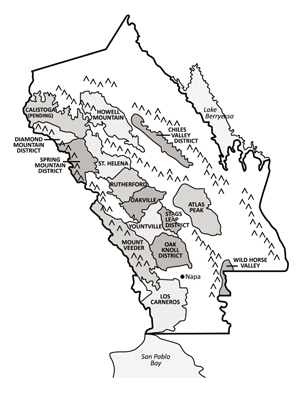California's Napa Valley is the best-known, most prestigious wine region in America. And yet only about four percent of California’s wine comes from the vineyard lands of Napa Valley! Most of Napa Valley’s wineries are small operations, although a few large wineries, such as Robert Mondavi Winery, Beringer, and Sutter Home, are based in Napa County.
Many Napa Valley wineries own large vineyards, which surround their properties like gorgeous manicured lawns. Other wineries don’t own vineyards but instead buy their grapes from independent grape growers or buy juice or bulk wine from other wine producers. And some Napa Valley wine producers don’t have their own wineries; they bring their grapes to custom-crush wine facilities, which they rent — all for the distinction of making “Napa Valley wine.”
The regions of Napa
Reading about Napa Valley and its wines can be confusing at times because the name Napa actually applies to three entities:
The political entity is Napa County.
The city of Napa, situated at the southern end of the county, is the county seat.
Napa Valley is the name of the AVA — that is, the official American Viticultural Area within Napa County.
For all practical purposes, the territory within the Napa Valley AVA is the same as that within Napa County. (The AVA doesn’t encompass Lake Berryessa in the eastern part of the county, for example, but no one could grow grapes there, anyway.)
Mapping Napa Valley
Napa Valley is not large: It’s about 30 miles long and 5 miles wide at its widest point, around the city of Napa. To put that in an international perspective, it’s only about one-eighth the size of France’s famous Bordeaux wine region.
In addition to the broad Napa Valley AVA and the even broader (six-county) North Coast AVA, Napa Valley has 14 distinct viticultural areas that are considered subappellations of the Napa Valley AVA itself. An additional subappellation, Calistoga, is pending. The following are the standing Napa Valley AVAs:
Mount Veeder; Spring Mountain District; Diamond Mountain District
Oak Knoll District; Yountville; Oakville; Rutherford; St. Helena
Howell Mountain; Stags Leap District; Atlas Peak
Chiles Valley District
Wild Horse Valley
Los Carneros
 Napa Valley and its AVAs.
Napa Valley and its AVAs.
Napa Valley's climate
Although not a large area, Napa Valley has an enviable range of soil types and climatic differences:
Mountains surround Napa Valley on both sides — the Mayacamas Mountains to the west and the Vaca Mountains to the east.
The Napa River runs north-south through the valley. Soils vary according to how close to the river a vineyard is or how far into the hills or mountains it is, among other factors.
The climate in Napa Valley is generally warm and dry, but a dominant feature of the region is the combination of cool winds and fog that sweeps up the valley from the San Pablo Bay in the south.
Summer weather in the southern part of the valley, in wine districts such as Carneros, Yountville, and Oakville, can be distinctly cooler than that of the Calistoga area at the north end of the valley.
Napa Valley sits next to Sonoma County. The Mayacamas Mountains separate the two counties from each other for most of their length, but in the south, the terrain is open and flatter, and driving from one county to the other is easier. In fact, the two counties share a wine district, Los Carneros, at their southern ends.

